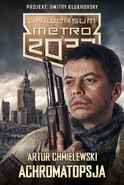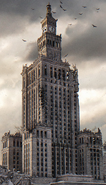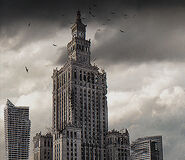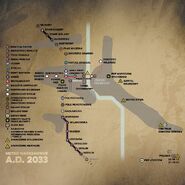mNo edit summary Tag: Visual edit |
No edit summary Tag: Source edit |
||
| Line 7: | Line 7: | ||
|Language = Polish (original) |
|Language = Polish (original) |
||
|Genre = Post-apocalyptic fiction |
|Genre = Post-apocalyptic fiction |
||
| + | |Publisher = [[Inisignis]] |
||
|Publication Date = March 2017 (Poland) |
|Publication Date = March 2017 (Poland) |
||
|Media Type = Print |
|Media Type = Print |
||
Revision as of 20:19, 6 November 2021
| “ | I know that fans have been waiting for a Varsovian novel of the Universe of Metro 2033 for a long time... and here it is! Thanks to Artur Chmielewski, "Achromatopsia" reaches your hands. And despite the meaning of its title it is not at all without colour! On the contrary: it keeps you in suspense and surprises you. Good work! | „ |
— Dmitry Glukhovsky | ||
Achromatopsia (Polish: Achromatopsja) is a novel that is part of the Universe of Metro 2033, a long-running series of short stories, novellas and novels written by different authors, all set in the world of Metro. Achromatopsia, written by Polish author Artur Chmielewski, was originally published in March of 2017. Although there is currently no English version of the book, Achromatopsia may be translated to Russian like other titles from the series that were originally created in a different language.
Although a number of short stories from the Universe series have taken place in Warsaw before Chmielewski's book was published, Achromatopsia is the first full novel to be set in Poland's capital. Just like Tullio Avoledo's The Roots of Heaven, it is one of the few books in the franchise to be written from a mostly first-person perspective, as opposed to the third-person narratives that dominate the Metro 2033 label.
Synopsis
Most of the (relatively small yet numerous) bombs dropped over Warsaw were detonated in the troposphere, resulting in a minimal shockwave with a maximal diffusion field of the so-called active material. For the city this meant limited physical destruction of its structures, but high levels of radiation. Moreover, many of the weapons used were of a bio-chemical nature, primarily affecting organic matter; in just hours animals and people died in immense torment - turning into a fetid, muddy slush. Vegetation blackened and crumbled into dust, while wood turned into a spongy toxic mass. As a result of the atomic warfare, nuclear winter began to reign over Warsaw and continued to freeze over its areas even in the year 2033.
Fortunately for the people of Poland's capital, Warsaw has a metro system that consists entirely of underground stations only, which means that anyone lucky enough to find themselves on the subway during Armageddon could survive by taking shelter in the confines of the Varsovian Metro. It did not take long for the Poles who persevered to start banding into separate, sometimes warring, fractions. The fragmentation of the subterranean society continued until the appearance of a new enemy from the surface: various new forms of grey-skinned lifeforms, deadly and adapted to the needs of life above ground. A council of leaders from each station was formed, bringing humans somewhat closer together in order but also driving them further beneath the earth to save themselves from the mutated wildlife.
In 2033, upon the discovery of a radio signal from the southeastern outskirts of Warsaw, the council meets at Ratusz Arsenał station and selects 12 representatives from the metro to find its source (3 thugs from the football hooligans of Wawrzyszew, 2 representatives from the Radom Coalition, 2 from Wilanowska, 2 scholars from Politechnika, 1 man from the Vietnamese at Świętokrzyska, as well as a priest and his helper from the New Vatican at Plac Wilsona station). Among them are Julia from Imielin, Seba from Wawrzyszew, Father Alex Bujak, Dũng Nguyễn, and the Doctor accompanied by our unnamed protagonist from Politechnika. They are led by their elusive guide, the stalker known as Franz. As their perilous journey seems to herald only more death, the aim and true purpose of their mission becomes unclear.
Trivia
- The book's name is derived from a condition called achromatopsia, also known as "total colour blindness", a medical syndrome that makes the person unable to perceive any colours as well making their eyesight worse when at high light levels (such as exterior daylight).
- The front cover of Achromatopsia portrays Franz, one of the main characters of the novel, holding his trademark shortened Kalash.





